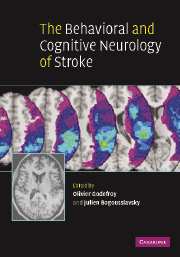Book contents
- Frontmatter
- Contents
- Contributors
- Preface
- 1 Evaluation of cognitive and behavioral disorders in the stroke unit
- Motor and gestural disorders
- Aphasia and arthric disorders
- 4 Aphasia in stroke
- 5 Acute vascular aphasia
- 6 Dysarthria
- 7 Alexia and agraphia in acute and chronic stroke
- 8 Acalculia and Gerstmann's syndrome
- Hemineglect, Anton–Babinski and right hemisphere syndromes
- Agnosia and Bálint's syndrome
- Executive and memory disorders
- Behavioral and mood disorders
- Dementia and anatomical left/right syndromes
- Index
- References
4 - Aphasia in stroke
Published online by Cambridge University Press: 10 October 2009
- Frontmatter
- Contents
- Contributors
- Preface
- 1 Evaluation of cognitive and behavioral disorders in the stroke unit
- Motor and gestural disorders
- Aphasia and arthric disorders
- 4 Aphasia in stroke
- 5 Acute vascular aphasia
- 6 Dysarthria
- 7 Alexia and agraphia in acute and chronic stroke
- 8 Acalculia and Gerstmann's syndrome
- Hemineglect, Anton–Babinski and right hemisphere syndromes
- Agnosia and Bálint's syndrome
- Executive and memory disorders
- Behavioral and mood disorders
- Dementia and anatomical left/right syndromes
- Index
- References
Summary
Introduction
Stroke related aphasia occurs in certain patterns, forming predictable aphasic syndromes, creating a basis for cortical localizationist models and providing reliable diagnosis and prognosis. Approximately 25% of stroke patients have significant aphasia (Leske, 1981), making this a common neurological and rehabilitation issue. Broca (1861) established the importance of the left hemisphere in language and Wernicke (1874) extended the description of aphasic syndromes including comprehension deficit, recognizing the sensorimotor organization of language accompanying anteroposterior anatomical distinction. Upon these foundations, a number of aphasic syndromes have been described subsequently. The taxonomy of these syndromes has been much debated, but in Table 4.1 the most commonly accepted classification and terminology are defined.
The cerebral cortex, specialized for language, functionally unique and anatomically localizable, similar to the primary motor or visual cortex, has become an important topic for research. There is anatomical and physiological evidence for overlapping networks specialized for language, output and comprehension. The characteristics of such networks can be summarized as follows:
A function is usually represented at multiple sites, so that lesions from multiple sites can produce a similar deficit.
Each area may belong to several overlapping networks, so a lesion in a single area often produces multiple deficits.
Severe and lasting deficit of function occurs when all or most structural components of a network are involved.
- Type
- Chapter
- Information
- The Behavioral and Cognitive Neurology of Stroke , pp. 53 - 74Publisher: Cambridge University PressPrint publication year: 2007
References
- 2
- Cited by



